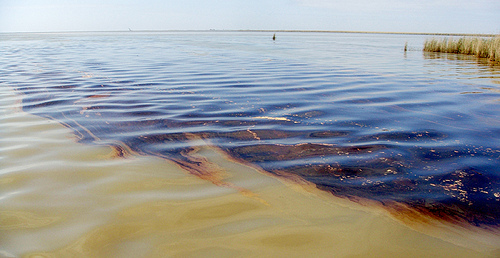Perspectives from the oil spill scientific symposium
 Earlier this month at the Deepwater Horizon Oil Spill Scientific Symposium at Louisiana State University (LSU), scientists emphasized the importance and urgency of consulting with researchers during the remediation of the Gulf of Mexico disaster. The meeting pulled together more than 200 attendees, including officials from the National Oceanic and Atmospheric Administration (NOAA), the U.S. Geological Survey (USGS), the Environmental Protection Agency (EPA) and the National Science Foundation (NSF).
Earlier this month at the Deepwater Horizon Oil Spill Scientific Symposium at Louisiana State University (LSU), scientists emphasized the importance and urgency of consulting with researchers during the remediation of the Gulf of Mexico disaster. The meeting pulled together more than 200 attendees, including officials from the National Oceanic and Atmospheric Administration (NOAA), the U.S. Geological Survey (USGS), the Environmental Protection Agency (EPA) and the National Science Foundation (NSF).
As listed on the agenda, the meeting—hosted by the Consortium of Ocean Leadership—was organized “to identify for the Federal Agencies the existing gaps in the scientific knowledge, opportunities to fill those gaps and priorities for short- and long-term research needs to understand the impact of the spill on the Gulf ecosystems and human health.”
Chris D’Elia, Dean of the School of the Coast and Environment at LSU, said during his opening remarks: “Several weeks ago, [President and CEO of the Consortium for Ocean Leadership Bob Gagosian] and I were discussing the need to have a meeting outside Washington at the site of the spill on the Gulf Coast. Our thoughts were that local expertise and perspectives would be critical in understanding and responding to this serious situation.”
At this meeting, researchers had a chance to speak with officials in small group discussions. Jim O’Donnell from the University of Connecticut who attended the meeting made one major recommendation: Officials should implement a coordinated program to survey the extent of the subsurface oil plume and to compare the amount observed to the amount discharged so that the effectiveness of the survey can be assessed. As he explained in an email:
Estimates of the amount washed up on marshes and beaches, lost to evaporation, oxidized by bacteria and settled on the bottom can be made. The rest should be included in mapped area. The effectiveness of the dispersant[s] in making small particles that can be oxidized by bacteria also needs to be observed at the depths and temperatures where the oil is found. And the rate of oxidation and the chemical products needs to be determined as well.
My colleagues from [the University of Connecticut] expressed support for the use of fluorescence techniques for rapid surveying and identification in the water and for monitoring the volatile components of the oil mixture so that the rate of transfer to the atmosphere can be quantified and the potential effect of these gases on humans understood.
Before the small group discussions, Under Secretary of Commerce for Oceans and Atmosphere and NOAA Administrator Jane Lubchenco, Director of USGS Marcia McNutt and Tim Killeen, NSF Assistant Director of Geosciences, reviewed the current challenges they are facing in the Gulf and priorities for research. As Killeen said during his presentation regarding the need for researchers to acquire and share data on the Gulf:
“Here at NSF we believe it is a false dichotomy to separate out the fundamental from the applied since we are dealing with nature here…We are about the knowledge base at NSF. That is what we bring here, that is what we will focus on.” NSF recently funded several grants to support research on oil spill assessment and remediation in the Gulf.
Jim O’Donnell stated that data collection efforts were discussed by Jane Lubchenco regarding the estimates of the discharge rates and the extent of the surface plume. She also suggested in her presentation that a workshop should be set up “to review results and harmonize approaches to date before any additional cruises [to take samples] are planned, except for required monitoring activities.” Lubchenco mentioned a need for “a more holistic ecosystem approach to understanding long-term impacts of MC252,” the leaking Mississippi Canyon well.
In general, O’Donnell said, attendees at the meeting were mainly academic researchers: “Bob Gagosian took a poll and roughly half the audience was from the Gulf area, while the rest were from across the US.” Notable federal attendees included Adm. Thad Allen, U.S. Coast Guard Commandant and others from Minerals Management Service, the White House Office of Science and Technology, as well as representatives from British Petroleum. O’Donnell said that after the presentations, a few questions from the audience were addressed, mostly regarding access to data:
The leaders responded that [many resources were] available and that there were legal restrictions that needed to be respected. My impression is that most people wanted to see data so they could understand what was being observed, and where. This is, obviously, central to determining what else should be done.
A report on the meeting should be released soon, according to Gregg Schmidt from Ocean Leadership; it is set to be published online at http://www.oceanleadership.org/ocean-policy-legislation/gulf-oil-spill-scientific-symposium/ early next week.